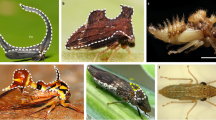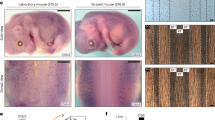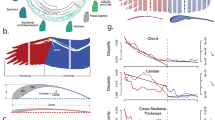Abstract
The complex, geometric colour patterns of many animal bodies have important roles in behaviour and ecology. The generation of certain patterns has been the subject of considerable theoretical exploration, however, very little is known about the actual mechanisms underlying colour pattern formation or evolution. Here we have investigated the generation and evolution of the complex, spotted wing pattern of Drosophila guttifera. We show that wing spots are induced by the Wingless morphogen, which is expressed at many discrete sites that are specified by pre-existing positional information that governs the development of wing structures. Furthermore, we demonstrate that the elaborate spot pattern evolved from simpler schemes by co-option of Wingless expression at new sites. This example of a complex design developing and evolving by the layering of new patterns on pre-patterns is likely to be a general theme in other animals.
This is a preview of subscription content, access via your institution
Access options
Subscribe to this journal
Receive 51 print issues and online access
$199.00 per year
only $3.90 per issue
Buy this article
- Purchase on Springer Link
- Instant access to full article PDF
Prices may be subject to local taxes which are calculated during checkout





Similar content being viewed by others
Accession codes
Data deposits
Gene sequences from D. guttifera and D. deflecta have been deposited at GenBank under accession numbers GU591398–GU591403.
References
Cott, H. B. Adaptive Coloration in Animals (Methuen & Co LTD, London, 1940)
Meinhardt, H. Models of Biological Pattern Formation (Academic Press, 1982)
Nijhout, H. F. The Development and Evolution of Butterfly Wing Patterns (Smithsonian Institution Press, 1991)
Bard, J. B. L. A model for generating aspects of zebra and other mammalian coat patterns. J. Theor. Biol. 93, 363–385 (1981)
Liu, R. T., Liaw, S. S. & Maini, P. K. Two-stage Turing model for generating pigment patterns on the leopard and the jaguar. Phys. Rev. E74, 011914 (2006)
Turing, A. M. The chemical basis of morphogenesis. Phil. Trans. R. Soc. B 237, 37–72 (1952)
Meinhardt, H. Pattern-formation and the activation of particular genes. Fortschr. Zool. 26, 163–174 (1981)
Gierer, A. & Meinhard, H. Theory of biological pattern formation. Kybernetik 12, 30–39 (1972)
Kondo, S. & Shirota, H. Theoretical analysis of mechanisms that generate the pigmentation pattern of animals. Semin. Cell Dev. Biol. 20, 82–89 (2009)
Parichy, D. M., Turner, J. M. & Parker, N. B. Essential role for puma in development of postembryonic neural crest-derived cell lineages in zebrafish. Dev. Biol. 256, 221–241 (2003)
Parichy, D. M., Rawls, J. F., Pratt, S. J., Whitfield, T. T. & Johnson, S. L. Zebrafish sparse corresponds to an orthologue of c-kit and is required for the morphogenesis of a subpopulation of melanocytes, but is not essential for hematopoiesis or primordial germ cell development. Development 126, 3425–3436 (1999)
Parichy, D. M. et al. Mutational analysis of endothelin receptor b1 (rose) during neural crest and pigment pattern development in the zebrafish Danio rerio. Dev. Biol. 227, 294–306 (2000)
Iwashita, M. et al. Pigment pattern in jaguar/obelix zebrafish is caused by a Kir7.1 mutation: Implications for the regulation of melanosome movement. PLoS Genet. 2, e196 (2006)
Watanabe, M. et al. Spot pattern of leopard Danio is caused by mutation in the zebrafish connexin41.8 gene. EMBO Rep. 7, 893–897 (2006)
Kondo, S. & Asai, R. A reaction–diffusion wave on the skin of the marine angelfish Pomacanthus. Nature 376, 765–768 (1995)
Nakamasu, A., Takahashi, G., Kanbe, A. & Kondo, S. Interactions between zebrafish pigment cells responsible for the generation of Turing patterns. Proc. Natl Acad. Sci. USA 106, 8429–8434 (2009)
Yamaguchi, M., Yoshimoto, E. & Kondo, S. Pattern regulation in the stripe of zebrafish suggests an underlying dynamic and autonomous mechanism. Proc. Natl Acad. Sci. USA 104, 4790–4793 (2007)
Walter, M. F. et al. Temporal and spatial expression of the yellow gene in correlation with cuticle formation and dopa decarboxylase activity in Drosophila development. Dev. Biol. 147, 32–45 (1991)
Wittkopp, P. J., True, J. R. & Carroll, S. B. Reciprocal functions of the Drosophila Yellow and Ebony proteins in the development and evolution of pigment patterns. Development 129, 1849–1858 (2002)
Wittkopp, P. J., Vaccaro, K. & Carroll, S. B. Evolution of yellow gene regulation and pigmentation in Drosophila. Curr. Biol. 12, 1547–1556 (2002)
Prud’homme, B. et al. Repeated morphological evolution through cis-regulatory changes in a pleiotropic gene. Nature 440, 1050–1053 (2006)
Gompel, N., Prud’homme, B., Wittkopp, P. J., Kassner, V. A. & Carroll, S. B. Chance caught on the wing: cis-regulatory evolution and the origin of pigment patterns in Drosophila. Nature 433, 481–487 (2005)
Harding, K., Hoey, T., Warrior, R. & Levine, M. Autoregulatory and gap gene response elements of the even-skipped promoter of Drosophila. EMBO J. 8, 1205–1212 (1989)
Goto, T., Macdonald, P. & Maniatis, T. Early and late periodic patterns of even skipped expression are controlled by distinct regulatory elements that respond to different spatial cues. Cell 57, 413–422 (1989)
Gómez-Skarmeta, J. L. et al. Cis-regulation of achaete and scute: shared enhancer-like elements drive their coexpression in proneural clusters of the imaginal discs. Genes Dev. 9, 1869–1882 (1995)
Simpson, P., Woehl, R. & Usui, K. The development and evolution of bristle patterns in Diptera. Development 126, 1349–1364 (1999)
Horn, C. & Wimmer, E. A. A versatile vector set for animal transgenesis. Dev. Genes Evol. 210, 630–637 (2000)
Blair, S. S. A role for the segment polarity gene shaggy-zeste white 3 in the specification of regional identity in the developing wing of Drosophila. Dev. Biol. 162, 229–244 (1994)
Chen, W. S. et al. Asymmetric homotypic interactions of the atypical cadherin Flamingo mediate intercellular polarity signaling. Cell 133, 1093–1105 (2008)
Simmonds, A. J., dos Santos, G., Livne-Bar, I. & Krause, H. M. Apical localization of wingless transcripts is required for Wingless signaling. Cell 105, 197–207 (2001)
Neumann, C. J. & Cohen, S. M. A hierarchy of cross-regulation involving Notch, wingless, vestigial and cut organizes the dorsal/ventral axis of the Drosophila wing. Development 122, 3477–3485 (1996)
Zecca, M., Basler, K. & Struhl, G. Direct and long-range action of a wingless morphogen gradient. Cell 87, 833–844 (1996)
Perlman, S. J., Spicer, G. S., Shoemaker, D. D. & Jaenike, J. Associations between mycophagous Drosophila and their Howardula nematode parasites: a worldwide phylogenetic shuffle. Mol. Ecol. 12, 237–249 (2003)
Baker, N. E. Embryonic and imaginal requirements for wingless, a segment-polarity gene in Drosophila. Dev. Biol. 125, 96–108 (1988)
van den Heuvel, M., Nusse, R., Johnston, P. & Lawrence, P. A. Distribution of the wingless gene-product in Drosophila embryos: a protein involved in cell-cell communication. Cell 59, 739–749 (1989)
Baker, N. E. Transcription of the segment-polarity gene wingless in the imaginal disks of Drosophila, and the phenotype of a pupal-lethal wg mutation. Development 102, 489–497 (1988)
Tanaka, R. et al. Notch-, Wingless-, and Dpp-mediated signaling pathways are required for functional specification of Drosophila midgut cells. Dev. Biol. 304, 53–61 (2007)
Noordermeer, J., Johnston, P., Rijsewijk, F., Nusse, R. & Lawrence, P. A. The consequences of ubiquitous expression of the wingless gene in the Drosophila embryo. Development 116, 711–719 (1992)
Struhl, G. & Basler, K. Organizing activity of Wingless protein in Drosophila. Cell 72, 527–540 (1993)
Campbell, G., Weaver, T. & Tomlinson, A. Axis specification in the developing Drosophila appendage: the role of wingless, decapentaplegic, and the homeobox gene aristaless. Cell 74, 1113–1123 (1993)
Lawrence, P. A. Wingless signalling: more about the Wingless morphogen. Curr. Biol. 11, R638–R639 (2001)
Carroll, S. B. et al. Pattern-formation and eyespot determination in butterfly wings. Science 265, 109–114 (1994)
Rebeiz, M. & Posakony, J. W. GenePalette: a universal software tool for genome sequence visualization and analysis. Dev. Biol. 271, 431–438 (2004)
Ashburner, M., Golic, K. G. & Hawley, R. S. Drosophila: A Laboratory Handbook (Cold Spring Harbor Laboratory Press, 1989)
Wheeler, M. R. & Clayton, F. E. A new Drosophila culture technique. Drosoph. Inf. Serv. 40, 98 (1965)
Spradling, A. C. & Rubin, G. M. Transposition of cloned P elements into Drosophila germ line chromosomes. Science 218, 341–347 (1982)
Sturtevant, M. A., Roark, M. & Bier, E. The Drosophila-rhomboid gene mediates the localized formation of wing veins and interacts genetically with components of the Egf-R signaling pathway. Genes Dev. 7, 961–973 (1993)
Bainbridge, S. P. & Bownes, M. Staging the metamorphosis of Drosophila melanogaster. J. Embryol. Exp. Morphol. 66, 57–80 (1981)
Markow, T. A. & O’Grady, P. M. Drosophila. A Guide to Species Identification and Use (Elsevier Inc, 2006)
Acknowledgements
We thank S. Blair and E. Bier for suggesting Wingless as a candidate inducer; E. Wimmer for the piggyBac, mariner, Hermes and Minos transposon vectors; E. Hare and M. Eisen for the D. guttifera genomic library; M. Rebeiz, K. Vaccaro, V. Kassner, J. Selegue and B. Prud’homme for technical advice; A. Martinez-Arias for discussions; J. Jaenike for D. nigromaculata flies; H. Krause and L. Baev for the UAS-wg construct; B. Prud’homme, H. Dufour, M. Rebeiz, H. Chung and T. Shirangi for comments on the manuscript; and L. Olds for help with the artwork. This work was supported by a Human Frontiers Science Program Fellowship (LT00640/2005-L) to T.W., a JSPS Postdoctoral Fellowship for Research Abroad to S.K., a National Institutes of Health Postdoctoral fellowship (GM076935) to T.M.W., and the Howard Hughes Medical Institute (S.B.C.).
Author Contributions T.W. and S.K. contributed equally to the experimental work. T.M.W. identified crossvein CREs from several species. T.W., S.K. and S.B.C wrote and prepared the manuscript for publication.
Author information
Authors and Affiliations
Corresponding author
Ethics declarations
Competing interests
The authors declare no competing financial interests.
Supplementary information
Supplementary information
This file contains Supplementary Figures 1-5 with legends, a Supplementary Discussion and Supplementary References. (PDF 1984 kb)
Rights and permissions
About this article
Cite this article
Werner, T., Koshikawa, S., Williams, T. et al. Generation of a novel wing colour pattern by the Wingless morphogen. Nature 464, 1143–1148 (2010). https://doi.org/10.1038/nature08896
Received:
Accepted:
Published:
Issue Date:
DOI: https://doi.org/10.1038/nature08896
This article is cited by
-
Thermal plasticity of wing size and wing spot size in Drosophila guttifera
Development Genes and Evolution (2023)
-
A CYC–RAD–DIV–DRIF interaction likely pre-dates the origin of floral monosymmetry in Lamiales
EvoDevo (2022)
-
A combined RAD-Seq and WGS approach reveals the genomic basis of yellow color variation in bumble bee Bombus terrestris
Scientific Reports (2021)
-
The color pattern inducing gene wingless is expressed in specific cell types of campaniform sensilla of a polka-dotted fruit fly, Drosophila guttifera
Development Genes and Evolution (2021)
-
Judging a salmon by its spots: environmental variation is the primary determinant of spot patterns in Salmo salar
BMC Ecology (2018)
Comments
By submitting a comment you agree to abide by our Terms and Community Guidelines. If you find something abusive or that does not comply with our terms or guidelines please flag it as inappropriate.



